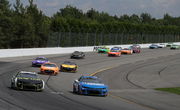
via Imago
Denny Hamlin

via Imago
Denny Hamlin
Last weekend’s NASCAR Cup Series race at Martinsville Speedway was not an exciting watch for the fans. While the race wasn’t bad, it certainly did not live up to the expectations of short-track racing events, ones that are known for thrilling action and drama. This could be an alarming sign for the sport that is trying to regain its glory. Plus, going by the current trend of parity racing, it just won’t fare well for the sport in the long run.
Denny Hamlin was quick to highlight NASCAR’s failed effort. Stating that the idea of bringing about parity has its negative effects, which were on display last Sunday at Martinsville. He further went on to explain the limitations of the Next Gen car from his own experience during the race, where he struggled to make a normal pass on a car that was a lap down.
ADVERTISEMENT
Article continues below this ad
Hamlin explains the pitfalls of racing with the Next Gen car
One of the key takeaways from the Cook 400 race was the lap traffic. This played a huge role in the change of lead drivers, but at the same time, it proved to be a challenge for drivers like Hamlin to make a pass. Hamlin found himself in a similar situation where he was kept at bay by Austin Dillon, who wasn’t even in contention to win the race. All of this was possible because of the parity racing trend NASCAR has put in place.
On his podcast show, Hamlin explained how difficult passing is with the next-gen car, “We couldn’t even pass Austin Dillon for 50 or 60 laps. The last car on the racetrack, we could not pass him at the end of Stage 2. So here’s the problem, and I need someone to answer this is that if your goal is parity and everyone, all the cars to be the same, who do you think passing will happen? Do they think that one driver can overcome the dirty air the car in front of him is creating?”
He further explained that he is only reiterating the common sentiment after the Martinsville race, “The racing needs to be fixed. I’m not saying anything that no one is not gonna be saying entire week, they’ve already said it. I’m sure the DBC guys will have issues with it; certainly, the teardown and the media have voiced their opinion on it. And I agree with them. Because if we sit back and do nothing, then shame on us, we deserve whatever is coming to us in the long run.”
Like Hamlin usually does, he also shared his ideas and potential solutions to better future short-track races.
ADVERTISEMENT
Article continues below this ad
Trending
More horsepower and tire changes over Aero gimmicks
Given the fact that the Next Gen car is the same for the teams and drivers, the new aerodynamic package just isn’t enough to bring about changes. Moreover, it was a bit surprising that tire wear didn’t come into play at Martinsville, which adds a layer of trickery for the drivers to deal with. Sounding like a broken record, Hamlin’s suggestion for NASCAR was once again to bump up the horsepower of the race car to make any notable difference in the style of racing.
“We keep tinkering with aerodynamics, I’m sorry we’re running 45 miles an hour in the middle of Martinsville. It’s not aerodynamics, it’s a horsepower to tire ratio. And until we get that through our fixed goals, the product will remain the same. But it will have to come up from the high-ups from NASCAR.” Hamlin added.
ADVERTISEMENT
Article continues below this ad
The race at Bristol Motor Speedway earlier this season was a good example of how racing can be made unpredictable and fun. So it will be interesting to see if NASCAR indeed decides to make any changes to its racing product.
Read More: Denny Hamlin Believes “Available for Hire” Dale Jr Is the Key to Fix NASCAR’s Short Track Problems
ADVERTISEMENT
ADVERTISEMENT
ADVERTISEMENT
ADVERTISEMENT






